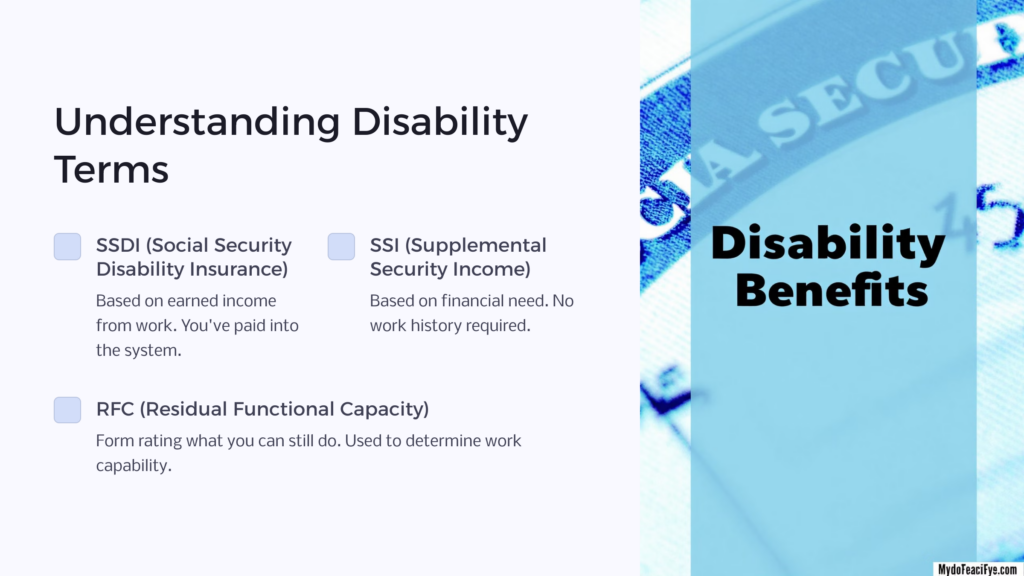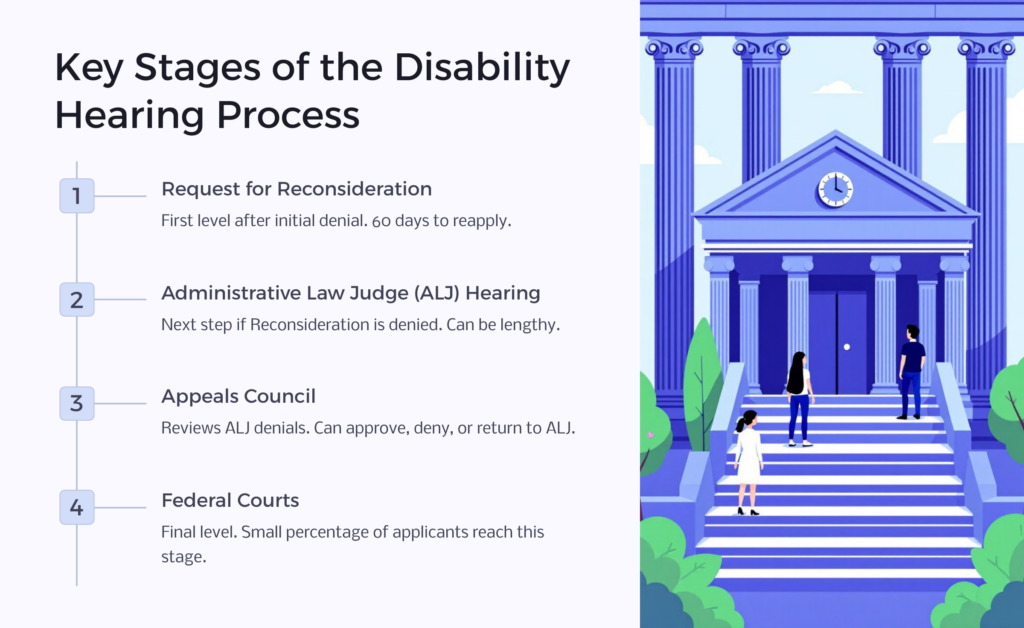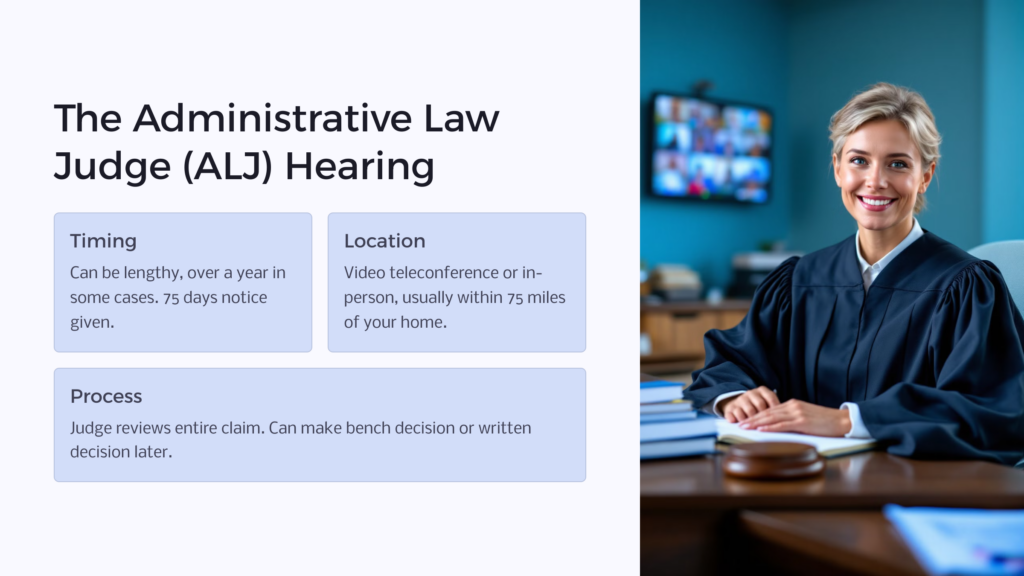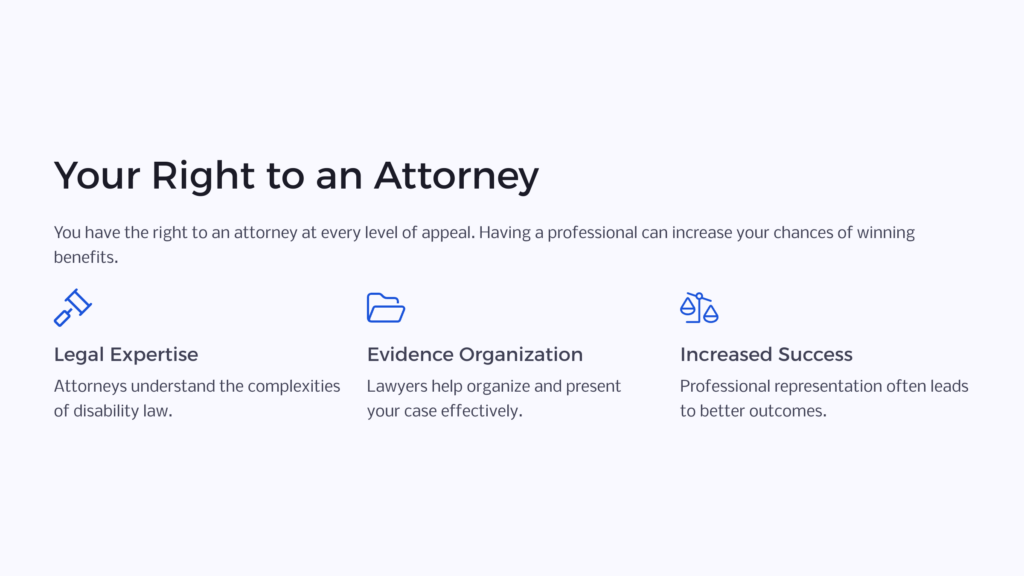Applying for disability is never simple. If it were, there wouldn’t be hundreds of web pages devoted to explaining it. If you are thinking about applying or have recently applied, you should be aware that most claimants do not receive disability benefits the first time they apply.
The majority of disability allowances happen later on, in front of a judge. But the hearings process is more complicated than one paper application and a hearing in front of a judge. The disability hearing process has several steps and deadlines.
Important Facts About the Disability Hearing Process
- Disability Legal Terms
- Stages of the Hearing Process
- What to Expect in the Disability Hearing Room
- Your Right to a Disability Attorney
- When and Where Is the Hearing?
- Tips for a Speedy Disability Hearing
It is important to emphasize that 90% of Social Security Disability claimants will get a decision in the first three stages of the disability decision process: initial, reconsideration, or ALJ review. Very few individuals, whether by themselves or with the aid of a disability attorney, will go to the level of Appeals Council (AC), and still fewer will get a decision from the courts.
A Brief Review of Disability Terms: SSDI, SSI, and RFC

Before discussing the disability hearing process, we should look at three abbreviations commonly used in the world of disability benefits: SSDI, SSI, and RFC.
SSDI stands for “Social Security Disability Insurance.” Whereas SSI means “Supplemental Security Income.” SSI and SSDI are different types of claims (although some people qualify for both).
SSDI is also called Title 2 or “entitlement benefits” because this type of disability benefit is based on earned income from a job. If you have worked, it means you paid into the system – therefore SSDI is your right. You’ve earned it.
SSI, on the other hand, is more of a traditional welfare program. For people who’ve had bad luck, been unable to work, or simply grew up impoverished—SSI is there to help. You do not need a work history of any kind to receive SSI. Your eligibility for SSI is based on need. If you have little money or few resources, you may qualify under SSI.
For both SSDI and SSI you do need to prove a physical or mental impairment that keeps you from working, and it must be considered severe enough to last a full year.
An “RFC” stands for Residual Functional Capacity. Residual means “what you still have left.” Functional means what you can do. Capacity refers to your ability. An RFC is a form (filled out by doctors) that rates what you can still do. It’s used to decide if you can do past work or some other type of work.
As an example, an RFC might rate you as capable of doing “light” work. What is light work? It means a job where you stand on your feet for 4-6 hours a day, and where you pick up objects weighing between 10 and 20 pounds. Examples of light work include teaching or being a hairdresser.
Your RFC – which you will see if you get a copy of your file after the Initial and Recon levels – is a very important document. It can determine whether your claim is allowed.
When to Request a Hearing
Before you can begin collecting Social Security Disability (SSDI) or Supplemental Security Income (SSI) disability benefits, you must receive a favorable or partially favorable medical decision on your disability claim.
This means you have to be found disabled under Social Security law, that is you must be “unable to engage in any substantial gainful activity by reason of any medically determinable physical or mental impairment which can be expected to result in death or which has lasted or can be expected to last, for a continuous period of not less than twelve months.”
If your initial claim was denied and you either filed a reconsideration appeal and it was denied or you live in one of the few parts of the country that does not have a reconsideration appeal level and you believe you are disabled according to Social Security law, your next step is to request a hearing on SSA-501 form. You must file your hearing request within sixty days of receiving the prior denial, which is considered to be sixty-five days from the date on the written denial notice. (An extra five days is allowed for the notice to reach you through the mail.) This means that Social Security must receive your request within sixty-five days.

The Stages of Disability Hearings
- Request for Reconsideration
- Administrative Law Judge (ALJ) hearing
- After an ALJ Hearing
- Appeals Council
- Federal Courts
Reconsideration
The first level of the Disability Hearing process is a simple one called Request for Reconsideration (commonly called Reconsideration, or Recon). When the first application is denied, the claimant (you) has 60 days to reapply for Reconsideration. This time period is the same whether you apply by yourself or get help from a disability lawyer. Any reputable lawyer will be well-aware of the 60-day deadline.
If you miss this deadline, a reasonable explanation to the SSA office is usually accepted. However, it is highly recommended to reapply as soon as possible. Filing for Reconsideration is very similar to what you did at the initial level: Fill out an application and submit it to Social Security Disability.
Submit information about all new medical sources, medications, or medical tests
Apply within 60-days of receiving written notice of denial from SSA
Contact your new Disability Examiner immediately – Recon cases can be adjudicated more quickly than initial ones
Your claim will be routed to the Disability Determination Services (DDS) office where another doctor (or doctor’s) and another Disability Examiner (DE) will review it. Some of these cases are approved, especially if your medical condition is worse or if there is additional medical evidence to show that you are not recovering as expected. Most disability claims at this level are denied.
Administrative Law Judge

If SSA sends you written notice that your Recon application has been denied, the next step is to seek an ALJ decision. This step can be lengthy, over a year in some cases.
You must apply for ALJ review within 60 days. You, or your disability attorney, should also collect any updated medical records and a list of medical sources to submit to the ALJ office as soon as possible.
The ALJ reviews your entire claim and the judge will make the disability decision. He or she is assisted by other disability professionals, but the ALJ office does not employ medical experts and does not schedule medical exams.
After you request an ALJ hearing, your local SSA office will forward your case file to the ALJ Hearing Office. Because of the ALJ travel schedule, COVID restrictions, and a large number of other claims, you may choose to see the judge via video teleconference. This is a good choice since video appointments are faster to schedule and you won’t need to travel. Please note that currently ALL claims are by video and SSA has not announced if this will change.
There are 169 Hearing Offices in the US and close to half of all hearings are typically held in rural areas. In total, ALJs review over 650,000 claims each year. You will receive a written notice, either online or mailed, at least 75 days before your hearing and it will outline when and where to go. You will need access to a computer for a teleconference.
If you choose the in-person option, it will usually be held 75 miles from where you live. We recommend this option as soon as it is available unless you live somewhere very remote. Should problems arise, such as a flare of your impairment that makes attending the hearing impossible, notify the SSA as soon as possible in writing.
The judge may hold the record open for you to submit additional documentation either at your (or your attorney’s) request or at the judge’s request. Submission of additional information, of course, extends the amount of time before the decision is made. The letter writing phase can be prolonged if the office has a large volume of decisions backed up waiting for letters. In that case, your appeal may sit in the writing department for a while before being assigned to a writer and having the letter written.
In a small percentage of appeals, the ALJ will make a bench decision to approve your claim, meaning that the judge says at the end of the hearing that he or she is approving your claim. However, even with a bench decision, the judge has to prepare a detailed written decision to approve the claim and the letter has to be written and approved; so a bench decision may not speed up your receipt of a formal decision and payment action is not initiated until the formal decision letter has been sent. Also, note that in most appeals, the judge will not make a bench decision at the hearing.
The Appeals Council (AC)
If you are denied by the ALJ, the next step is the AC, or Appeals Council. The AC level includes you and a Hearing Officer, sometimes also called an Appeals Officer. The Hearing Officer represents the SSA and the Disability Determination Services (DDS). At the AC level, many people decide to hire an attorney. The DDS will defend its decision – your denial – unless there is new evidence.
The AC consists of Administrative Appeals Judges and Appeals Officers who consider appeals from ALJ denials. This office also performs quality review and court-related functions.
To get the AC process started you can use the SSA link and download a request for a Hearing Review. You (or your attorney) may also file by calling your local SSA office. You have 60 days from the time you received written notice that the ALJ denied your claim. The ALJ decision is also sometimes called the “bench decision.”
If the Appeals Council deems the bench decision was correct, they may swiftly deny your appeal. Or, the AC may decide to review your case. Their last option is to return your case to ALJ for a second look. The AC will consider the same issues that the Administrative Law Judge considered, even those issues that were favorably decided in your case.
You or your disability lawyer will receive a written copy of the Appeals Council’s final action on your case. You will have 60 days to file an appeal at the next level, in court.
Federal Courts
A very small percentage of disability applicants take their claims to a federal court. If the Appeals Council adjudicates against you, or if they send your claim back to the ALJ who denies it, you may file a civil suit. This is the final level of the disability hearing process.
You will file in the judicial district in which you live, or where you have your principal place of business. If you do not live within a judicial district or have a business in one, however, you may file your civil action in the United States District Court for the District of Columbia.
It’s important to send any copies of the complaint you filed and of the summons issued by the court to the SSA. This mail must be certified or registered and mailed to the Social Security Administration’s Office of the General Counsel for your area.
At this stage, almost all claimants have a disability lawyer. Currently, the courts are seeing claimants and their attorneys via teleconference.
Between October 2018 and September 2019, the SSA took in just over 17,000 new court cases. And during that same time, they processed nearly the same number (about 16,500 claims).
What to Expect in the Disability Hearing Room
People often ask questions, such as: How long does a disability hearing last? What do I say at a disability hearing?
Hearings can be brief, as little as 15 minutes. New medical evidence may have swayed a judge to approve or deny your claim. But if you do not have new evidence and have brought several witnesses, you could spend an hour in front of the judge.
What should you say? It’s best to read a written statement if you think you’ll be nervous. Avoid going off-topic. Be ready to explain why you didn’t see a doctor for years or have other gaps in your medical history. Most of all, be honest and don’t try to exaggerate your symptoms or complaints.
Even if you decide not to hire a disability attorney, you have several advantages when you finally sit before the judge—even if it’s by video. First, the ALJ will see you. If you are having trouble sitting, standing, moving, speaking, or any other problems because of your impairment, the judge will observe it first-hand. Second, the ALJ process makes it easier for judges to approve rather than deny claims. They must write long explanations for a denial, whereas an approval requires far less paperwork.
You may bring witnesses to your hearing, including friends, family, and experts. A vocational expert, doctor, or psychologist are considered “expert witnesses” and they can make a big difference. Most disability lawyers will recommend bringing at least one expert witness.
Many claimants are approved at the ALJ level. By the time a claimant has made it this far, one out of three will be approved. Some claimants who are denied at this level decide to move forward.
Your Right to an Attorney
 The SSA specifically notes that you have a right to an attorney at every level of appeal, including during the initial stage, Reconsideration, in front of an Administrative Law Judge, the Appeals Council, or for subsequent court hearings. All are opportunities for you to hire a disability lawyer.
The SSA specifically notes that you have a right to an attorney at every level of appeal, including during the initial stage, Reconsideration, in front of an Administrative Law Judge, the Appeals Council, or for subsequent court hearings. All are opportunities for you to hire a disability lawyer.

Your right to an attorney should not be taken lightly. Having a professional on your side will not only bring peace of mind and help you organize evidence, but you are more likely to win benefits.
Disability law is a growing field. The complexities of the SSA system and the hearing levels make it necessary for some legal professionals to spend whole careers mastering how the disability system works.
When and Where Is the Hearing?
Hearings can be teleconferenced or in person. Currently, due to the COVID pandemic, all hearings are being held via teleconference. It is possible that due to the extended nature of this pandemic, all future SSA hearings may be via teleconference.
As for timing, this can vary quite a bit. Some claimants will see a judge within a few months, but many can wait six months or more. The volume of cases is difficult to predict, but during periods of high unemployment (such as during 2020) many more people will apply for disability. This means it may take longer for SSA to adjudicate claims.
Tips for a Speedy Disability Hearing
- Reapply as soon as you receive a written denial notice, which will allow you the quickest hearing date possible.
- Appoint a lawyer or other representative as early as possible.
- Submit all additional evidence at least five days in advance to the ALJ. This step can make an ALJ hearing completely unnecessary if the medical evidence shows you cannot work.
- Do not reschedule at ALJ or AC level.
- At the AC hearing, you and your representative should only request copies of hearing recordings and exhibits from the ALJ hearing if you need them for your appeal.
- A videoconference (the only current) option is always faster
What About VA Di
ability Hearings over the Phone?
Disability phone hearings are convenient and an alternative to in-person hearings—especially when transportation or illness are obstacles. Here’s how to conduct and schedule these hearings while mitigating the potential disadvantages of this format.
Conducting a Disability Hearing Over the Phone
When conducting a disability hearing over the phone, creating an environment conducive to clear communication is crucial. Find a quiet, private space to minimize distractions. Test your phone connection and ensure a reliable signal. Speak clearly and articulate your points effectively. If needed, request clarification from the administrative law judge or representative. Be prepared with necessary documents and evidence, organized for easy reference. Taking notes during the hearing can also help you remember important details for future reference.
Scheduling a Disability Hearing Over the Phone
Scheduling a disability hearing over the phone is a straightforward process. Once you have applied for benefits and received a hearing date, confirm your participation by phone or email. Ensure you provide accurate contact information. If you have specific scheduling constraints, inform the Social Security Administration (SSA) promptly. The SSA will coordinate the date and time with the administrative law judge and notify you of any changes.
Avoiding the Disadvantages of Over-the-Phone Hearings
While the convenience of over-the-phone hearings is undeniable, certain challenges should be addressed to ensure a fair and successful hearing. Poor audio quality or misinterpretation of non-verbal cues can pose challenges. To mitigate these issues, request a videoconference hearing instead.
Having a trusted representative or attorney present during the hearing can provide valuable support.
Wait Times for a Social Security or SSI Hearing Date
Although the window for filing the hearing request is short, the wait for being assigned a hearing date ranges from long to very long—typically twelve to eighteen months and in some areas as much as two years. The variation in wait times from one Office of Disability Adjudication and Review (ODAR) (aka hearing office) to another is related to how many hearing requests are processed through a specific hearing office and the number of judges available in each office.
Social Security publishes a list of statistics on average hearing date wait periods for all the hearing offices. The list, which is organized alphabetically by the city in which the ODAR office is situated can be found at https://www.ssa.gov/appeals/DataSets/01_NetStat_Report.html.
Statistics show that each Administrative Law Judge clears two or less hearing decisions a day. Average processing times from request for hearing to the issuance of a decision letter range from 144 to 855 days with most falling in the 400 to 680-day range (13 months to a little less than two years).
Wait Times for a Decision after the Hearing
To determine how long it might take you to receive a decision letter after your hearing is held, you can look up the average number of days from request to decision letter from your hearing office at https://www.ssa.gov/appeals/DataSets/05_Average_Processing_Time_Report.html.
From that total length of time, subtract the average wait for a hearing date in your ODAR. The difference between the two times is an estimate of how long you might wait for your decision after the hearing. This calculation requires converting to days the average number of wait months for a hearing date.
Here’s an example: The Spokane, Washington ODAR averages 504 days from request to decision letter being mailed. The office’s average waiting period to the day of the hearing is 16 months. Because we are calculating estimates, we do not have to be exact, so we multiply 16 months times 30 days to arrive at an average hearing date waiting time of 480 days. If every claim were on average, you would be sent a decision from the Spokane ODAR within 24 days of the hearing (504 – 480).
Of course, averages are made up by extremes on both ends. The guideline for judges to complete hearing decisions is sixty days and many decisions are made in that time frame or less; a substantial number of others take ninety days or more.
If sixty days have passed since your hearing and you have not received a decision, you can follow up on your disability claim status by calling your ODAR to inquire where your claim is in the post-hearing appeals process. Your ODAR’s phone number can be found on the letter notifying you of your hearing date.
If you experience dire financial need while waiting for a hearing date or for a decision after the hearing, such as eviction or foreclosure proceedings, homelessness, or the inability to receive medical treatment for a life-threatening illness, you can submit a statement of dire need with a request for expedited handling. If you do so, be sure to attach copies of documents to support your statement. If the dire need statement is accepted as valid, your hearing request or decision will be moved up in line but still behind all the dire need requests submitted before yours.
While You Wait for a Decision
Post-hearing processing consists of three general steps: the judge makes the decision; the decision is communicated to the decision letter writing department where it is assigned to a writer; and once the letter is written, it is sent to the judge for review and signature before it is sent to you. If the judge finds an error in the letter, fourth and fifth steps are added: the letter is returned for editing (correcting) and then is sent back to the judge for second review and signature.
Understanding the Disability Hearing Process
If you’ve been denied benefits, you will want to appeal the decision. It makes sense to get help from a disability attorney, but it isn’t 100% necessary in all cases. Whatever you decide to do, use this as a guide to how the hearing process works. Your best bet is to persevere because the extra effort will usually result in winning disability benefits.
 Benefits.com Advisors
Benefits.com Advisors
With expertise spanning local, state, and federal benefit programs, our team is dedicated to guiding individuals towards the perfect program tailored to their unique circumstances.
Rise to the top with Peak Benefits!
Join our Peak Benefits Newsletter for the latest news, resources, and offers on all things government benefits.




















